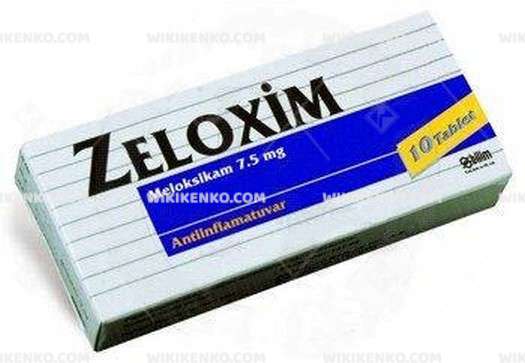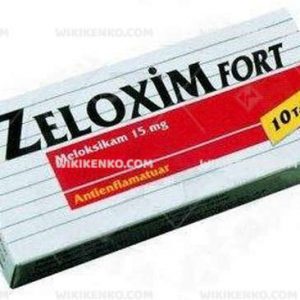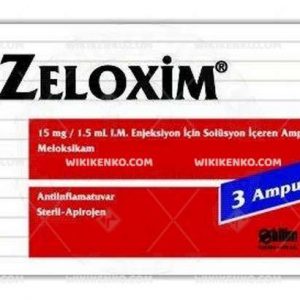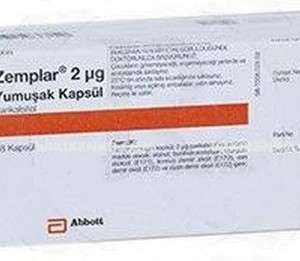Zeloxim Tablet
In the realm of arthritis and related inflammatory conditions, a formidable ally emerges in the form of Zeloxim Tablet. This pharmaceutical agent, enriched with the potency of meloxicam, casts its healing touch upon osteoarthritis, rheumatoid arthritis, ankylosing spondylitis, and beyond. This article embarks on a journey to illuminate the multifaceted dimensions of it, exploring its mechanism of action, diverse applications, dosage nuances, and the intricacies of side effects and drug interactions.
| Dosage form | |
|---|---|
| Pack size | |
| Potency | 7.5 Mg |
| Manufacturer | |
| Origin | |
| Generic Name (Ingredient) | Meloxicam 7.5 Mg |
Assuming your emergency circumstances for this product, visit Urgent Quotation page. Besides, for any pharmaceutical questions, please ask us in the comments section.
Description
Mechanism of Action
Zeloxim operates as a cyclooxygenase inhibitor, proficiently targeting both COX-1 and COX-2 enzymes. This dual inhibition sets into motion a reduction in the synthesis of prostaglandin precursors, substances intricately woven into the fabric of inflammation. Notably, it exhibits a penchant for COX-2, potentially mitigating the gastrointestinal repercussions associated with its use.
Applications
The medicinal utility of Zeloxim extends its protective embrace to a spectrum of conditions, including:
- Osteoarthritis: A prevalent affliction, where it provides solace with a recommended dosage of 7.5 mg/day, with potential escalation to 15 mg/day if the need arises.
- Rheumatoid Arthritis: An inflammatory challenge, where a standard dosage of 15 mg/day is advised. In elderly patients, long-term treatment is orchestrated with a prudent 7.5 mg/day regimen.
- Ankylosing Spondylitis: Zeloxim bestows its anti-inflammatory prowess in this condition, aligning with the dosing regimen for rheumatoid arthritis.
- Dental Pain: This medication extends its therapeutic spectrum to include the management of dental pain.
- Neuropathic Pain: Neuropathic pain finds relief through Zeloxim’s pharmacological prowess.
- Inflammatory Pain: It’s efficacy in alleviating inflammatory pain further diversifies its application.
- Juvenile Rheumatoid Arthritis: In the realm of pediatric care, Zeloxim serves in pauciarticular and polyarticular juvenile rheumatoid arthritis, adapting to the unique needs of young patients.
- Postoperative Pain: The challenges of postoperative pain find a responsive solution in Zeloxim’s therapeutic embrace.
| Condition | Recommended Dosage | Special Considerations |
|---|---|---|
| Osteoarthritis | 7.5 mg/day | May increase to 15 mg/day if needed |
| Rheumatoid Arthritis | 15 mg/day | Elderly patients: 7.5 mg/day for long-term treatment |
| Ankylosing Spondylitis | 15 mg/day | Aligns with rheumatoid arthritis regimen |
| Dental Pain | Individualized | Consult healthcare provider |
| Neuropathic Pain | Individualized | Consult healthcare provider |
| Inflammatory Pain | Individualized | Consult healthcare provider |
| Juvenile Rheumatoid Arthritis | Individualized | Consult healthcare provider |
| Postoperative Pain | Individualized | Consult healthcare provider |
Side Effects
In the course of embracing Zeloxim, one may encounter an array of side effects, with varying frequencies and implications. These may encompass:
- Gastrointestinal Quandaries: Stomach discomfort, accompanied by nausea, vomiting, heartburn, diarrhea, constipation, and gas, occasionally find their place in the narrative.
- Dizziness: A sensation of dizziness may emerge, underscoring the necessity for vigilance during activities demanding mental acuity.
- Respiratory Encounters: A constellation of cold symptoms or flu-like manifestations may grace the clinical landscape.
- Cutaneous Expressions: In some individuals, Zeloxim’s therapeutic encounter may evoke skin reactions, with skin rash or urticaria surfacing.
- Lower Limb Edema: Edema of the lower limbs may transiently manifest during the therapeutic voyage.
In rare instances, the clinical tapestry may be adorned with more serious vignettes:
- Gastrointestinal Challenges: The prolonged use of Zeloxim can occasionally lead to gastrointestinal challenges, including ulcers and bleeding.
- Cardiovascular Thrombotic Events: These events, albeit infrequent, represent a possibility associated with Zeloxim’s use.
- GI Bleeding, Ulceration, and Perforation: The gastrointestinal realm may occasionally become a site of bleeding, ulceration, and perforation.
- Hepatic Encounters: Hepatotoxicity, albeit uncommon, necessitates attention.
- Cardiovascular Considerations: Hypertension and heart failure, in conjunction with edema, demand a place in the constellation of potential side effects.
- Renal Implications: Renal toxicity and hyperkalemia, although rare, occupy a segment of clinical considerations.
It is imperative to recognize that this compendium, though comprehensive, may not encompass the entirety of potential side effects. In the face of side effects that are severe or persistent, a consultation with a healthcare provider is the recommended course of action.
Interactions with other Medications
The pharmacological journey of Zeloxim may intertwine with other medications, giving rise to potential interactions. These encompass a repertoire of substances, including:
- Aspirin
- Duloxetine
- Omega-3 polyunsaturated fatty acids
- Escitalopram
- Metoprolol
- Sertraline
- Diphenhydramine
- Cyclobenzaprine
- Pregabalin
- Esomeprazole
- Acetaminophen / Hydrocodone
- Montelukast
- Levothyroxine
- Acetaminophen
- Cyanocobalamin
- Ascorbic acid
- Ergocalciferol
- Cholecalciferol
It is imperative to acknowledge that this list, though extensive, may not encompass the entirety of potential drug interactions. Thus, an open dialogue with a healthcare provider regarding all concurrently administered medications is a pivotal step to ensure safe and effective therapy.
Onset of Actions
Zeloxim, as a therapeutic entity, exhibits an exceptional bioavailability of 90% following oral administration, a testament to its efficient absorption from the gastrointestinal tract. The dynamics of onset unfold with a keen sense of swiftness. Following a single dose of Zeloxim, peak plasma concentrations manifest within 2 hours for the suspension and within 5-6 hours for solid oral dosage forms (tablets).
However, it is prudent to recognize that the onset of therapeutic action is a realm riddled with individual nuances, ranging from metabolism to age, health condition, and concurrent medications. Thus, the counsel of a healthcare provider, tailored to unique circumstances, is an indispensable beacon.
Precautions
The expedition with Zeloxim is marked by a trail of precautions, each designed to enhance the safety and efficacy of this therapeutic encounter. These precautions include:
General Precautions
- Zeloxim holds the potential to elevate the risk of fatal heart attacks or strokes, even in the absence of apparent risk factors.
- The prudent course of action dictates avoiding the use of Zeloxim immediately before or after coronary artery bypass surgery (coronary artery bypass graft, or CABG).
- Vigilance is key, as Zeloxim may occasionally provoke stomach or intestinal bleeding, a phenomenon that carries the shadow of fatality.
Symptoms that Demand Attention
In the course of Zeloxim use, certain symptoms should serve as beacons, prompting immediate contact with a healthcare provider. These include:
- The emergence of any skin rash, no matter how mild.
- The onset of shortness of breath, even during mild exertion.
- The manifestation of swelling or rapid weight gain.
- Signs of stomach bleeding, such as bloody or tarry stools, or the expulsion of blood or vomit resembling coffee grounds.
Storage Precautions
Zeloxim’s suspension should find its sanctuary at 77 degrees F (25 degrees C). Transient storage at temperatures between 59 and 86 degrees F (15 and 30 degrees C) is permissible. However, protection from heat, moisture, and light is non-negotiable. Furthermore, this medication should be stored beyond the reach of children and the realm of pets.
As a parting note, it is paramount to emphasize that the content herein, while comprehensive, does not constitute an exhaustive repository of information. In all matters pertaining to Zeloxim, the guidance of a healthcare provider stands as the ultimate source of personalized, precise information.
Zeloxim Tablet Benefits
In the mosaic of pharmaceutical interventions, Zeloxim Tablet, also known as Meloxicam, emerges as a nonsteroidal anti-inflammatory drug (NSAID) with a commendable array of benefits:
- Pain Relief: Zeloxim exudes efficacy in alleviating pain associated with a spectrum of conditions, including osteoarthritis, rheumatoid arthritis, and ankylosing spondylitis.
- Inflammatory Reckoning: By curbing the production of inflammatory mediators, Zeloxim champions the cause of reducing inflammation and swelling.
- Enhanced Mobility: The journey toward improved joint mobility finds an ally in Zeloxim, which alleviates pain and inflammation.
- Fever Suppression: It’s therapeutic repertoire extends to fever reduction.
- Prolonged Action: Boasting a substantial half-life, Zeloxim necessitates but one daily administration to unleash its therapeutic potential.
It is vital to underscore that while Zeloxim endows this constellation of benefits, its use should unfold under the watchful eye of a healthcare provider. The potential for side effects and interactions with other medications underscores the importance of professional guidance in this therapeutic voyage.
Conclusion
In the realm of arthritis and inflammatory conditions, Zeloxim Tablet stands as a beacon of hope, alleviating pain, curbing inflammation, and enhancing mobility. However, the path of pharmaceutical therapy, like all journeys, requires guidance and vigilance. As this article draws to a close, it reiterates the essential role of healthcare providers in ensuring the safe and effective use of it. The multifaceted nature of this medication necessitates a personalized approach, underscoring the value of professional medical guidance in the quest for well-being.
Use the form below to report an error
Please answer the questions as thoroughly and accurately as possible. Your answers will help us better understand what kind of mistakes happen, why and where they happen, and in the end the purpose is to build a better archive to guide researchers and professionals around the world.
The information on this page is not intended to be a substitute for professional medical advice, diagnosis, or treatment. always seek the advice for your physician or another qualified health provider with any questions you may have regarding a medical condition. Always remember to
- Ask your own doctor for medical advice.
- Names, brands, and dosage may differ between countries.
- When not feeling well, or experiencing side effects always contact your own doctor.
Cyberchondria
The truth is that when we’re sick, or worried about getting sick, the internet won’t help.
According to Wikipedia, cyberchondria is a mental disorder consisting in the desire to independently make a diagnosis based on the symptoms of diseases described on Internet sites.
Why you can't look for symptoms on the Internet
If diagnoses could be made simply from a textbook or an article on a website, we would all be doctors and treat ourselves. Nothing can replace the experience and knowledge of specially trained people. As in any field, in medicine there are unscrupulous specialists, differences of opinion, inaccurate diagnoses and incorrect test results.






Reviews
There are no reviews yet.